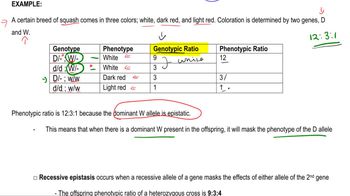3. Extensions to Mendelian Inheritance
Epistasis and Complementation
Practice this topic
- Multiple Choice
When performing a complementation test, how do you know if two mutations complement?
932views1rank - Multiple Choice
How can you tell if two genes are epistatic?
993views1rank1comments - Multiple Choice
Two heterozygous organisms are crossed, and the F2 phenotypic ratio is 12:3:1. What form of epistasis do these two genes exhibit?
759views1rank - Multiple Choice
A cross of white plants and red plants was performed. Using the F2 phenotypic ratio data below, determine what form of gene interaction is taking place.
580views3rank - Textbook Question
In the discussion, we focused on extensions and modifications of Mendelian principles and ratios. In the process, we encountered many opportunities to consider how this information was acquired. On the basis of these discussions, what answers would you propose to the following fundamental questions?
How did geneticists determine that inheritance of some phenotypic characteristics involves the interactions of two or more gene pairs? How were they able to determine how many gene pairs were involved?
693views - Textbook Question
Define and distinguish epistasis and pleiotropy.
617views - Textbook Question
A researcher interested in studying a human gene on chromosome 21 and another gene on the X chromosome uses FISH probes to locate each gene. The chromosome 21 probe produces green fluorescent color, and the X chromosome probe produces red fluorescent color.
If the subject studied is male, how many green and red spots will be detected? Explain your answer.
462views - Textbook Question
A researcher interested in studying a human gene on chromosome 21 and another gene on the X chromosome uses FISH probes to locate each gene. The chromosome 21 probe produces green fluorescent color, and the X chromosome probe produces red fluorescent color.
If the subject studied is female, how many green and red spots will be detected? Explain your answer.
467views




